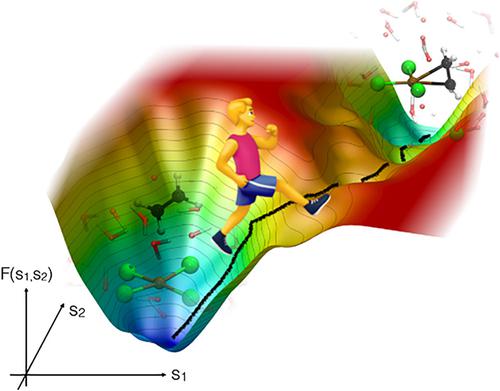当前位置:
X-MOL 学术
›
WIREs Comput. Mol. Sci.
›
论文详情
Our official English website, www.x-mol.net, welcomes your
feedback! (Note: you will need to create a separate account there.)
Exploring high‐dimensional free energy landscapes of chemical reactions
Wiley Interdisciplinary Reviews: Computational Molecular Science ( IF 16.8 ) Pub Date : 2018-11-16 , DOI: 10.1002/wcms.1398 Shalini Awasthi 1 , Nisanth N. Nair 1
Wiley Interdisciplinary Reviews: Computational Molecular Science ( IF 16.8 ) Pub Date : 2018-11-16 , DOI: 10.1002/wcms.1398 Shalini Awasthi 1 , Nisanth N. Nair 1
Affiliation

|
Molecular dynamics (MD) techniques are widely used in computing free energy changes for conformational transitions and chemical reactions, mainly in condensed matter systems. Most of the MD‐based approaches employ biased sampling of a priori selected coarse‐grained coordinates or collective variables (CVs) and thereby accelerate otherwise infrequent transitions from one free energy basin to the other. A quick convergence in free energy estimations can be achieved by enhanced sampling of large number of CVs. Conventional enhanced sampling approaches become exponentially slower with increasing dimensionality of the CV space, and thus they turn out to be highly inefficient in sampling high‐dimensional free energy landscapes. Here, we focus on some of the novel methods that are designed to overcome this limitation. In particular, we discuss four methods: bias‐exchange metadynamics, parallel‐bias metadynamics, adiabatic free energy dynamics/temperature‐accelerated MD, and temperature‐accelerated sliced sampling. The basic idea behind these techniques is presented and applications using these techniques are illustrated. Advantages and disadvantages of these techniques are also delineated.
中文翻译:

探索化学反应的高维自由能态势
分子动力学(MD)技术被广泛用于计算构象转变和化学反应的自由能变化,主要是在凝聚态系统中。大多数基于MD的方法都对先验选择的粗粒度坐标或集合变量(CV)进行了偏向采样,从而加速了从一个自由能盆地到另一个自由能盆地的不频繁过渡。通过增强对大量CV的采样,可以实现自由能估计的快速收敛。随着CV空间维数的增加,传统的增强采样方法变得越来越慢,因此,它们在高维自由能景观采样中效率极低。在这里,我们重点介绍旨在克服此限制的一些新颖方法。尤其是,我们讨论了四种方法:偏置交换元动力学,平行偏置元动力学,绝热自由能动力学/温度加速MD和温度加速切片采样。提出了这些技术背后的基本思想,并说明了使用这些技术的应用。还描述了这些技术的优点和缺点。
更新日期:2018-11-16
中文翻译:

探索化学反应的高维自由能态势
分子动力学(MD)技术被广泛用于计算构象转变和化学反应的自由能变化,主要是在凝聚态系统中。大多数基于MD的方法都对先验选择的粗粒度坐标或集合变量(CV)进行了偏向采样,从而加速了从一个自由能盆地到另一个自由能盆地的不频繁过渡。通过增强对大量CV的采样,可以实现自由能估计的快速收敛。随着CV空间维数的增加,传统的增强采样方法变得越来越慢,因此,它们在高维自由能景观采样中效率极低。在这里,我们重点介绍旨在克服此限制的一些新颖方法。尤其是,我们讨论了四种方法:偏置交换元动力学,平行偏置元动力学,绝热自由能动力学/温度加速MD和温度加速切片采样。提出了这些技术背后的基本思想,并说明了使用这些技术的应用。还描述了这些技术的优点和缺点。











































 京公网安备 11010802027423号
京公网安备 11010802027423号